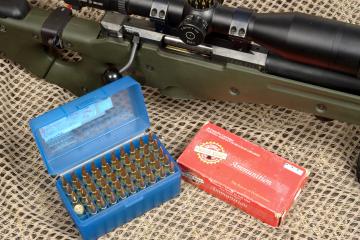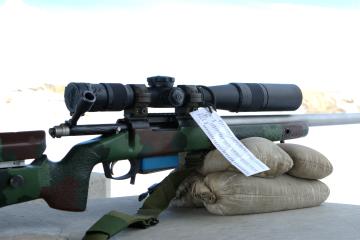For the reloader, lack of factory ammunition isn't a problem, but getting good components can be. A
good general rule is that if Lapua makes brass in your caliber, then buy it even though it is a
little more expensive. Its quality, consistency, and hardness alleviate the need for extensive
brass preparation and allows for less work in each successive reload iteration. Unfortunately, only
Remington produces .260 brass. I have found its hardness to be inconsistent, and some primers
pockets are a little loose even before the first firing. Since .260 is based on the .308 case,
reloaders can form .260 from .243, 7-08, and .308 cases, although this does add a couple extra steps
to brass preparation the first time.
There is some good news for reloaders. Nosler has just announced that it will be producing
NoslerCustom brass for the .260, with availability summer 2007. Silver State Armory has also done a
small run of custom .260 brass.
I am lucky to be part of a flourishing group of practical long-range shooters in the Colorado
region. In the last year, ten of us have put together rifles chambered in .260 Remington with
impressive results. About half of the new .260 shooters have decided to stop shooting .308, and
have just replaced the barrel on their main .308 rifle with a .260. Here are four representative
rifles from the group.

 Up until recently, there was no factory long-range ammunition for the .260 and reloading the
only way to go.
Black Hills Ammunition will have loads using the 139-grain Lapua Scenar available in 2007.
My primary long-range rifle had been an Accuracy International AWP (.308) for a couple years, so
when I fell into a screaming deal on a used AI-AW, I knew exactly what I was going to do with it. I
unscrewed the original barrel, and sent the action off to George Gardner at G.A. Precision to fit a
26-inch medium Palma profile 5R barrel from Rock Creek Barrels. The rifle was topped with a Schmidt
& Bender PMII 3-12x50 mm scope with a P4-Fine reticle and 1/10th mil click knobs. About a week
later, I was shooting .260 Remington loads through the rifle. With only about a week to develop a
good load before the 2006 Steel Safari match, I settled on a little over 41 grains of H4350 in
Remington brass with a CCI BR2 primer, topped with a 139-grain Lapua Scenar. It wasn't perfect, but
it got the job done. My dope was on and the rifle came through, letting me squeak by a better rifle
shooter and win the match by a hair's width. It's not a coincidence that he went on to build a .260.
I have since moved to using Lapua .243 brass necked up to 6.5 mm because it is harder and more uniform.
The Remington 700 is the most common rifle used for long-range shooting because it is relatively
cheap, good quality, and has lots of after-market parts available. My friend Michael built a spare
Remington action into a .260 rifle by adding a 24-inch three-groove Lilja barrel with one-in-eight
inch twist, tipped with a J.P. Enterprises Benny Cooley muzzle brake. The rifle wears a Nightforce
3.5-15x50mm NXS scope with NP-R2 reticle on a Badger 20 MOA base. Michael settled on a load using
Remington brass shooting the 123-grain Lapua Scenar at about 3000 fps using VV-N550.
The next rifle is an ArmaLite AR-10, which has been fitted with a 22-inch barrel from
J.P. Enterprises. The AR-10 is more finicky with regard to accuracy, and the gas system needs some
tuning to ensure function and reduce recoil with the .260. This is easily accomplished with a
J.P. adjustable gas block. This AR-10 gives good accuracy with the 142-grain SMK at about 2650 fps
using H4350 and necked-down 7-08 brass. The gas gun loses velocity compared to the bolt rifles and
is harder on brass.

 The Surgeon Tactical action provides an excellent basis around which to build a .260 or
6.5-08 Ackley Improved rifle.
My friend Chuck was seduced by the ballistics of 6.5-284 Norma but wanted to stay with a real
short-action cartridge. The solution was 6.5-08 Ackley Improved, which is a .260 case blown out to
have a steeper shoulder angle and less body taper. The benefit of the extra case capacity is an
additional 80 to 120 fps, however, cases must be fire-formed which takes time and eats away
additional barrel life. Since the Ackley Improved version is more overbore, it will burn out
barrels faster than .260 Remington. The straight walls of the Ackley Improved also do not work well
in double-stack double-feed magazines, such as those for the AI-AW and AR-10. Chuck's rifle was
built by TJ's gunsmithing in Aurora, Colorado around a Surgeon Tactical action, with a 26-inch
Krieger #10 MTU-contour barrel. Its McMillan A5 stock was fitted with the Badger AICS detachable
box magazine system. A US Optics 3.2-17x44 mm SN3 scope is mounted on USO rings directly to the
Surgeon receiver. In fire-formed brass, Chuck's load shoots the 142 Sierra MatchKing at 2900 fps
using H4831SC powder. Everyone who shoots this rifle compares it to a laser beam.
The .260 Remington provides long-range ballistics conventionally limited to the magnum calibers.
Because its parent case is the ubiquitous .308 Winchester, building a rifle in .260 can be as easy
as fitting a new barrel. The .260 provides much less wind drift and drop than .308 but has less
recoil. The hunting pedigree of 6.5 mm in Europe proves the caliber is formidable for practical
use. For long-range shooters who want a better cartridge than .308, but don't want the costs
associated with big overbore magnums, the .260 is just the ticket.
|